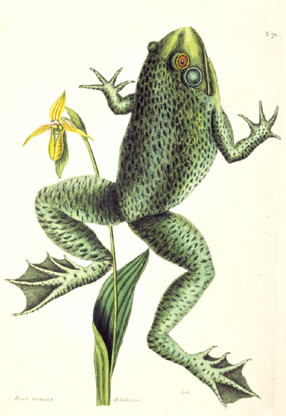|
The deep-throated early summer mating call of the
male Bullfrog can often be heard near New York City's ponds, lakes,
and streams. Its scientific name, Rana catesbeiana, honors
Mark Catesby (1683–1749), the British-born naturalist and artist
who depicted the Bullfrog, with a Yellow Lady Slipper, and many
other native animals and plants, in the earliest and most famous
American natural history book illustrated with colored plates. Largely
self-taught, both as artist and printmaker, Catesby came to the
southern colonies to study and depict the local flora, but then
shifted his attentions to the native wildlife. More than half of
the more than 200 illustrations depict birds, with the remainder
devoted to fish, mammals, reptiles, and insects. In most of the
illustrations Catesby paired the animal with either its food plant
or its botanical habitat.
|


